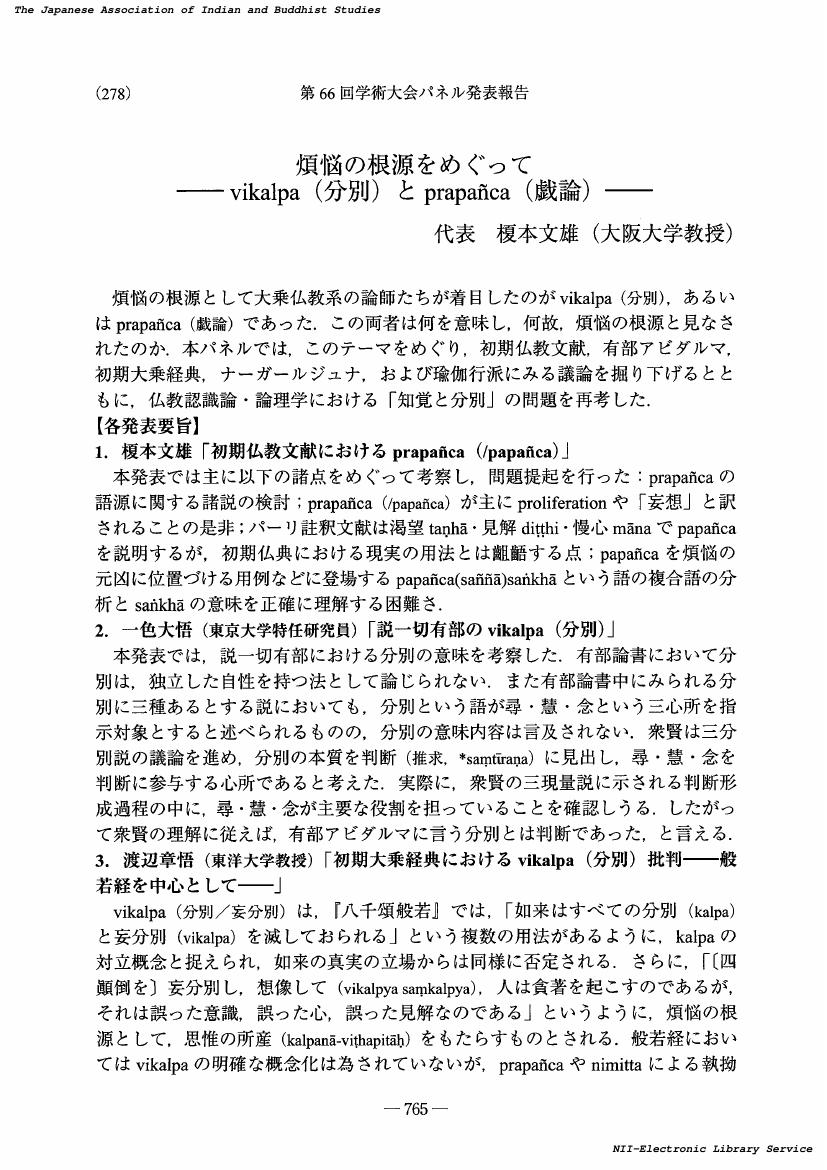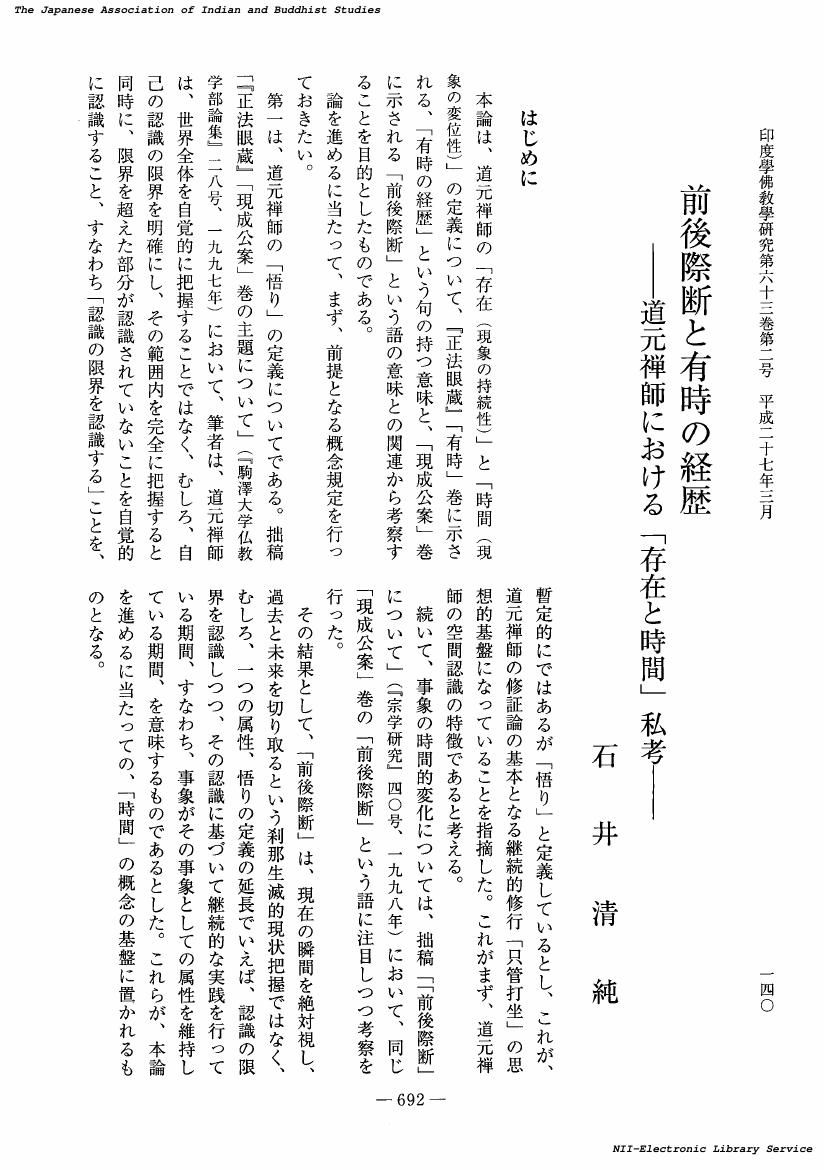1 0 0 0 『アビダルマディーパ』における『本論』
- 著者
- 三友 健容
- 出版者
- 日本印度学仏教学会
- 雑誌
- 印度學佛教學研究 (ISSN:00194344)
- 巻号頁・発行日
- vol.55, no.2, pp.875-867,1271, 2007
There are many untitled "<i>Sdstras</i>" which are quoted in the <i>Abhidharmadipa</i>, which I will abbreviate here as ≪<i>ADV</i>≫. Needless to say, we can understand what the author of the <i>ADV</i> stands upon by checking these quoted texts.<br>There are over 40 examples where Vasubandhu, the author of <i>Abhidharmakosabhasya</i> (<i>AKBh</i>), used "<i>Sastra</i>" in his text. Of these examples, the title of the <i>Prakarana-sastra</i> and the <i>Jñana prasthana</i> are known as the most common. On the other hand, "<i>Sastra</i>" is used in 20 sentences in the <i>ADV</i>. Of these, three refer to texts that are non-Buddhist, and the other 17 examples seem to be quoted from some of the so-called <i>Six pada-sastras</i>.<br>I have tried to check the standpoint of the dipakara, the author of the <i>ADV</i>, by researching these quoted "<i>Sastras</i>". Basically, the dipakara specifically mentions the title of "<i>Sastra</i>" only in reference to the <i>Prajñapti-bhasya</i>, <i>Prakarana-sastra</i> and the <i>Jñana-prasthana</i>. I could not find the titles of <i>Dhatukaya</i> and <i>Vijñana-kaya</i> mentioned anywhere, but I was able to identify sentences quoted from the <i>Abhidharmâvatara</i>, the <i>Prakarana-sastra</i>, the <i>Samgiti-paryaya</i>, the <i>Dharma-skandha</i>, the <i>Jñana-prasthana</i>, the <i>Mahavibhasa</i>, the <i>AKBh</i>, the <i>Nyayanusara</i> and the <i>Samayapradipika</i> by researching the use of the word of <i>sastra</i>. The dipakara even adopted the opinion of the <i>AKBh</i> when the latter represented the correct doctrine of the Sarvastivadin school.<br><i>AKBh</i> refers to "<i>Mahavibhasa</i>" as simply "<i>Vibhasa</i>", and the masters mentioned there by the term "<i>vaibhasika</i>". The <i>ADV</i>, however, refers to the same text as "<i>Vaibhasa</i>". It is not clear why <i>ADV</i> uses this form.<br>There are two possibilities why <i>ADV</i> uses the form "<i>Vaibhasa</i>":<br>1) "<i>Vaibhasa</i>" comes from the rule of the Sanskrit grammar which states that when a noun changes its vowel to vrddhi form, it means "that which belongs to or is affiliated with the original noun." In this case it means texts which belong to "<i>Vibhasa</i>."<br>2) <i>ADV</i> intentionally changed the word used by the dipakara's rival, Vasubandhu, because the dipakara hated him. In fact, the dipakara created many original expressions from words previously used in the <i>AKBh</i>.<br>I would like to suggest that the most likely possibility is the first. This would mean simply texts belonging to the Sarvastivadin School, because it is difficult to believe that the dipakara changed the title of the original text.<br>The major difference between the <i>ADV</i> and the <i>AKBh</i> is that the dipakara uses texts of the Madhyamika and Yogacaya schools to criticise Mahayana Buddhism.
1 0 0 0 『般若灯論』における説一切有部説 (二)
- 著者
- 三友 健容
- 出版者
- 日本印度学仏教学会
- 雑誌
- 印度學佛教學研究 (ISSN:00194344)
- 巻号頁・発行日
- vol.34, no.2, pp.778-784, 1986
- 著者
- 榎本 文雄
- 出版者
- 日本印度学仏教学会
- 雑誌
- 印度學佛教學研究 (ISSN:00194344)
- 巻号頁・発行日
- vol.64, no.2, pp.765-764, 2016-03-20 (Released:2017-09-05)
1 0 0 0 中世日蓮宗における本尊の造像について
- 著者
- 寺尾 英智
- 出版者
- 日本印度学仏教学会
- 雑誌
- 印度學佛教學研究 (ISSN:00194344)
- 巻号頁・発行日
- vol.65, no.1, pp.120-128, 2016
<p>Ittō ryōson 一塔両尊 is a style of <i>honzon </i>本尊, the main object of worship. It is a characteristic style of the medieval Nichiren sect. Ittō ryōson has the Daimoku 題目, and the calligraphy <i>Namu Myōhō Renge Kyō</i> 南無妙法蓮華経 in the center, and two Buddhas, Śākyamuni and Prabhūtaratna, on both sides. The style which has Śākyamuni and Prabhūtaratna on both sides itself is not peculiar to the Nichiren sect. It is based on the <i>Lotus Sutra</i>. However, Ittō ryōson is formed from the kernel of the Mandara honzon 曼荼羅本尊 designed by Nichiren 日蓮. There are some combinations of Śākyamuni's and Prabhūtaratna's <i>inzō</i> 印相, mudra. Ittō ryōson also has some varieties of <i>inzō</i>. Moreover, Ittō ryōson is the only instance in which both Śākyamuni and Prabhūtaratna in <i>gasshō-in</i> 合掌印. One instance of Ittō ryōson in which both Śākyamuni and Prabhūtaratna are so depicted was made in 1335. This style spread as peculiar to the Nichiren sect.</p>
1 0 0 0 OA 仏陀の最初説法と慈悲
- 著者
- 新井 一光
- 出版者
- 日本印度学仏教学会
- 雑誌
- 印度學佛教學研究 (ISSN:00194344)
- 巻号頁・発行日
- vol.67, no.1, pp.487-482, 2018-12-20 (Released:2019-09-07)
- 参考文献数
- 7
Because the Chinese translations of the Dharmaguptaka Vinaya and Mahīśāsaka Vinaya lack any equivalent of the term “being a compassionate one” (kāruññatā), which expresses the motivation for the Buddha’s first sermon in current Pāli texts, and because Śākyamuni had no consideration for others leading up to attaining his enlightenment, the phrase “ca ...... sattesu ca kāruññataṃ paṭicca” was likely added by later generations. This shows that compassion as a motivation behind the Buddha’s first sermon cannot be traced directly back to Śākyamuni himself. Therefore, it is understood that the Buddha’s first sermon is not based on compassion.Between the two motives of “Brahmā’s entreaty” and “kāruññatā”, the latter only holds any significance when occurring after Brahmā’s entreaty. Therefore, it is likely wrong to treat the idea of having compassion towards others as the same as recognizing Brahmā’s entreaty when trying to understand the motivation behind the Buddha’s first sermon. However, if one were to explore the intentions of the authors of the Pāli texts, I suppose Buddhists who understood the motive of “ca ...... sattesu ca kāruññataṃ paṭicca” were critical of the motivation behind the Buddha’s first sermon expressed by the Brahmā’s entreaty and held a negative view of its significance.
1 0 0 0 中古天台における教行證について
- 著者
- 小方 道憲
- 出版者
- 日本印度学仏教学会
- 雑誌
- 印度學佛教學研究 (ISSN:00194344)
- 巻号頁・発行日
- vol.2, no.2, pp.518-519, 1954
1 0 0 0 十住毘婆沙論の教行證
- 著者
- 藤谷 大圓
- 出版者
- 日本印度学仏教学会
- 雑誌
- 印度學佛教學研究 (ISSN:00194344)
- 巻号頁・発行日
- vol.3, no.1, pp.146-147, 1954
1 0 0 0 OA 前後際断と有時の経歴 ――道元禅師における「存在と時間」私考――
- 著者
- 石井 清純
- 出版者
- 日本印度学仏教学会
- 雑誌
- 印度學佛教學研究 (ISSN:00194344)
- 巻号頁・発行日
- vol.63, no.2, pp.692-699, 2015-03-20 (Released:2017-09-01)
1 0 0 0 のろんじ考 -呪禁師のながれ-
- 著者
- 岩佐 貫三
- 出版者
- 日本印度学仏教学会
- 雑誌
- 印度學佛教學研究 (ISSN:00194344)
- 巻号頁・発行日
- vol.24, no.1, pp.414-417, 1975
1 0 0 0 後期中観派に見る正理と勝義
- 著者
- 那須 真裕美
- 出版者
- 日本印度学仏教学会
- 雑誌
- 印度學佛教學研究 (ISSN:00194344)
- 巻号頁・発行日
- vol.53, no.2, pp.842-839, 2005
1 0 0 0 シャンカラの『ヨーガ・スートラ註解書解明』(下)
- 著者
- 中村 元
- 出版者
- 日本印度学仏教学会
- 雑誌
- 印度學佛教學研究 (ISSN:00194344)
- 巻号頁・発行日
- vol.26, no.1, pp.119-127, 1977
1 0 0 0 シャンカラの『ヨーガ・スートラ註解書解明』(上)
- 著者
- 中村 元
- 出版者
- 日本印度学仏教学会
- 雑誌
- 印度學佛教學研究 (ISSN:00194344)
- 巻号頁・発行日
- vol.25, no.1, pp.70-77, 1976
1 0 0 0 OA 南岳慧思の「無師自悟」についての考察(駒澤大学における第五十五回学術大会紀要(二))
- 著者
- 鶴田 大吾
- 出版者
- 日本印度学仏教学会
- 雑誌
- 印度學佛教學研究 (ISSN:00194344)
- 巻号頁・発行日
- vol.53, no.2, pp.702-704, 2005-03-20
1 0 0 0 OA 南岳慧思における頓覚思想の考察
- 著者
- 鶴田 大吾
- 出版者
- 日本印度学仏教学会
- 雑誌
- 印度學佛教學研究 (ISSN:00194344)
- 巻号頁・発行日
- vol.55, no.2, pp.579-582, 2007-03-20
1 0 0 0 OA 慧思の法華三昧前方便の考察
- 著者
- 鶴田 大吾
- 出版者
- 日本印度学仏教学会
- 雑誌
- 印度學佛教學研究 (ISSN:00194344)
- 巻号頁・発行日
- vol.54, no.1, pp.43-46, 2005-12-20
1 0 0 0 OA 南岳慧思における『鴦掘摩羅経』の引用 : 『法華経』と如来蔵思想に関して
- 著者
- 鶴田 大吾
- 出版者
- 日本印度学仏教学会
- 雑誌
- 印度學佛教學研究 (ISSN:00194344)
- 巻号頁・発行日
- vol.57, no.2, pp.781-785, 2009-03-20
1 0 0 0 OA 南岳慧思の如来蔵思想の考察 : 『仏蔵経』と『如来蔵経』との関連において
- 著者
- 鶴田 大吾
- 出版者
- 日本印度学仏教学会
- 雑誌
- 印度學佛教學研究 (ISSN:00194344)
- 巻号頁・発行日
- vol.56, no.2, pp.707-710, 2008-03-20
1 0 0 0 阿仏房について
- 著者
- 上田 本昌
- 出版者
- 日本印度学仏教学会
- 雑誌
- 印度學佛教學研究 (ISSN:00194344)
- 巻号頁・発行日
- vol.26, no.1, pp.43-48, 1977
1 0 0 0 摂津中嶋三宝寺とその周辺
- 著者
- 西岡 秀爾
- 出版者
- 日本印度学仏教学会
- 雑誌
- 印度學佛教學研究 (ISSN:00194344)
- 巻号頁・発行日
- vol.55, no.2, pp.1007-1004,1288, 2007
Sanboji in Settsu Nakajima is a temple built by Nonin in order to spread the Dharma sect. This article traces the origin of the temple by referring to literature of the Middle Ages and old maps.<br>Recently, the origin of the Sanboji temple has been traced to Daido-the second and third wards of the neighborhood of the Osaka University of Economics in Daido district. However, topography and medieval documents connected with the Sozenji, Monoi family, and so on, suggest that the origin of the temple is not restricted to Daido, but extends to the wider-ranging area of Komatsu Zuiko and Osumi district, spanning the whole territory. Although the time of existence of the temple is still unknown, it is believed to have existed until the third year of Onin (1469), based on the "摂州中嶋三宝寺六祖舎利大慧袈裟伝来記" of the Shoboji historical records. Furthermore, its existence during the time of Daiei (1521-1526) or Kyoroku (1528-1531) is questioned. Even though the temple disappeared, the Komatsu and Nishidaido districts located to the north from the origin of Sanboji were called Sanboji, and remained so until the first half of the 20th century.
1 0 0 0 『多武峯略記』にみられる「常行三昧」をめぐつて
- 著者
- 奈良 弘元
- 出版者
- 日本印度学仏教学会
- 雑誌
- 印度學佛教學研究 (ISSN:00194344)
- 巻号頁・発行日
- vol.26, no.2, pp.512-520, 1978






